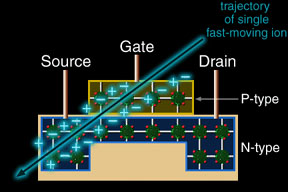 | When high velocity ions plow through semiconductor devices they produce a large number of electrons and holes that carry currents within these devices. In fact one electron-hole pair is formed for every 3.6 eV of energy deposited in the semiconductor during the collision (a very large number of electrons and holes). The proper functioning of semiconductor devices relies upon controlling the currents flowing through the device by carefully regulating the available electrons and/or holes. If a large number of electron-hole pairs are introduced in sensitive regions like memory cells, it can alter the information stored in the computer and produce phantom commands. Non-critical circuits may continue to function with false information; however, it can be devastating if impacts happens in control systems or decision-making circuits. Control systems can be switched into an undesired mode for which there is no reset option (called latch-up), circuits may be burned out, and even worse effects can occur if propulsion or spacecraft pointing systems are involved. In addition, these impacts degrade the semiconductor material, limiting their useful on-orbit lifetime. |





